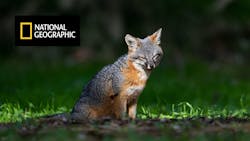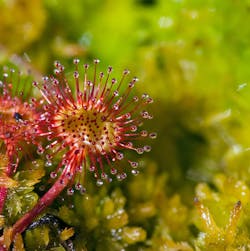Nat Geo Harnesses the Latest Tech to Capture Wildlife
What you’ll learn
- What is National Geographic’s America's National Parks series?
- What technology is used to capture such stunning video?
- Going in-depth about some key technology used in filming.
National Geographic (Nat Geo) launched its first magazine on September 22, 1888, just nine months after the Society was founded. Originally, it was a journal sent to 165 charter members; currently, it reaches 40 million people each month. And while the magazine will be discontinued on newsstands in 2024, it has branched out over the years to include many No.1-ranked shows that are viewed by millions all over the globe.
Though the articles featured in the publication are top-level, it's the photography that captured the reader's attention. The images from the 1930s are no less striking than the latest pics, all of which were done using the latest cameras through those time periods.
Nat Geo continues to provide incredible images and videos. However, the technology being employed today makes viewers stunned by what they see. Cameras are still a huge part of what makes Nat Geo great, but they have since capitalized on other tech to immerse us in those scenes and images.
Making the “Parks” Videos
Those amazing videos can be found on a number of Nat Geo shows, such as the first and second season of “America's National Parks,” which delves into the beauty of nature and wildlife in many different parks, including the Grand Canyon, Yosemite, the Everglades and more. Capturing those videos is a feat in itself.
In the Channel Islands, for example, there's a unique fox that only inhabits that park, so the production team utilized a silent drone to grab video without spooking the fox (Fig. 1). When capturing moments, the production team must think outside the box using what technology is available, or even create gadgets depending on the project.
“I think things are always changing with technology. And wildlife filmmaking has changed dramatically in the past five years, with things like drones alone. Because before, if you wanted to get aerial shots for a wildlife show, you would need a helicopter, which obviously is very expensive, very unsustainable, and very bad for the planet. And not many shows could do that," said Executive Producer Anwar Mamon. “So aerial views were few and far between. Whereas now, depending on the rules of the location you're in, you can carry a drone on your back and get incredible views of the natural world."
DSLR Cameras
Remote DSLR cameras are also deployed when it comes to certain animals being filmed in the wild. Some bears, for example, act like drones are a nuisance and will react differently by swatting or running from those airborne cameras, so prepositioned DSLR cameras are employed instead. Nat Geo often uses local intel and animal routes to position those cameras.
“And so, we're heavily reliant on that, because we can't often just put out 100 cameras—we can put out 20 very specific targeted areas,” said Mamon. “And that's often what we'll do. We might put remote cameras around a water source, like a water hole, or with bears, we might put cameras around a well-known scratching tree or post that we know they'll come to you. And then, you know, put lots of cameras around there to get different angles.”
Exploration Technology Lab
Much of the technology is produced by Nat Geo's Exploration Technology Lab, which has developed many different devices and camera setups for a myriad of applications. For example, teams used a motion-controlled robotic arm outfitted with a macro cam to pick up the tiny details of carnivorous plants that inhabit Lake Clark, National Park. The team can then program the robot to perform certain moves, eliminating any shaking to capture fine detailed images, including the plants devouring their prey (Fig. 2).
Underwater image capturing is another specialty of the Exploration Technology Lab. Teams have deployed Deep Ocean Drop Cams to gain insight into the bleaching of sea coral, which will expel algae living in their tissue when water becomes too warm. Those Drop Cams are fully autonomous and outfitted with HD cameras and lights inside a pressurized glass housing.
“So coral, coral is very susceptible to changes in temperature. And ocean temperatures around the world are rising. One way that all reacts to rising temperatures is to actually produce something that can be called its own sunscreen. And that's a way that it kind of tries to protect itself against rising temperatures," said Mamon. "Now that sunscreen, if you will, is the thing that actually glows in the dark, and that's something we wanted to capture in Biscayne National Park.
“So, we had to take an ultraviolet lighting rig with some specialist cameras to show how this coral was doing and how it was reacting to a changing climate. And you know, the shots are beautiful. But there is a message behind that, and that's this coral is starting to get heat stressed. And you know, if we want to keep coral alive, we've got to think of different ways to help it cope with rising temperatures.”
These are just a few technologies Nat Geo employs to bring us stunning shows and images. There's also conservation tech that includes advanced imaging sensors and machine-learning algorithms and systems that provide real-time data for monitoring biodiversity, patterns, and trends, such as detecting illegal fishing and poaching. So, the next time you watch a special or series from Nat Geo, remember all of the technology it took to produce them!
About the Author
Cabe Atwell
Technology Editor, Electronic Design
Cabe is a Technology Editor for Electronic Design.
Engineer, Machinist, Maker, Writer. A graduate Electrical Engineer actively plying his expertise in the industry and at his company, Gunhead. When not designing/building, he creates a steady torrent of projects and content in the media world. Many of his projects and articles are online at element14 & SolidSmack, industry-focused work at EETimes & EDN, and offbeat articles at Make Magazine. Currently, you can find him hosting webinars and contributing to Electronic Design and Machine Design.
Cabe is an electrical engineer, design consultant and author with 25 years’ experience. His most recent book is “Essential 555 IC: Design, Configure, and Create Clever Circuits”
Cabe writes the Engineering on Friday blog on Electronic Design.



